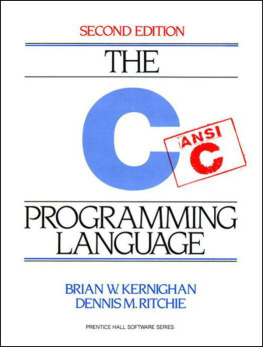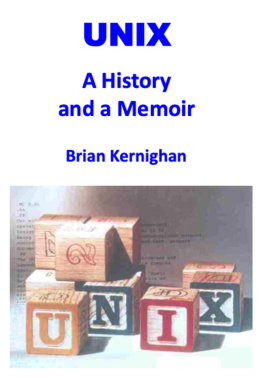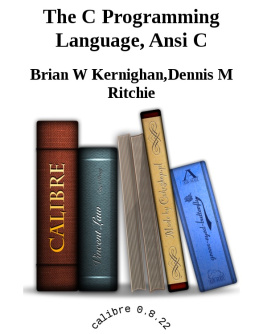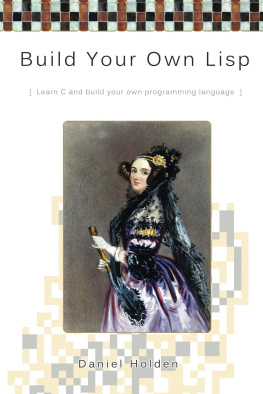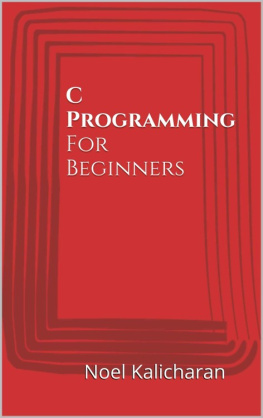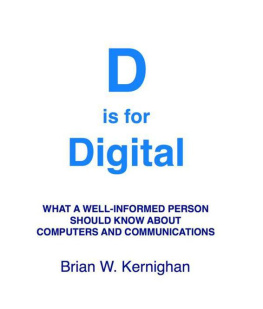Kernighan Brian W. - C Programming Language (2nd Edition)
Here you can read online Kernighan Brian W. - C Programming Language (2nd Edition) full text of the book (entire story) in english for free. Download pdf and epub, get meaning, cover and reviews about this ebook. year: 1988, publisher: Pearson Education (USA), genre: Computer. Description of the work, (preface) as well as reviews are available. Best literature library LitArk.com created for fans of good reading and offers a wide selection of genres:
Romance novel
Science fiction
Adventure
Detective
Science
History
Home and family
Prose
Art
Politics
Computer
Non-fiction
Religion
Business
Children
Humor
Choose a favorite category and find really read worthwhile books. Enjoy immersion in the world of imagination, feel the emotions of the characters or learn something new for yourself, make an fascinating discovery.
- Book:C Programming Language (2nd Edition)
- Author:
- Publisher:Pearson Education (USA)
- Genre:
- Year:1988
- Rating:5 / 5
- Favourites:Add to favourites
- Your mark:
- 100
- 1
- 2
- 3
- 4
- 5
C Programming Language (2nd Edition): summary, description and annotation
We offer to read an annotation, description, summary or preface (depends on what the author of the book "C Programming Language (2nd Edition)" wrote himself). If you haven't found the necessary information about the book — write in the comments, we will try to find it.
C Programming Language (2nd Edition) — read online for free the complete book (whole text) full work
Below is the text of the book, divided by pages. System saving the place of the last page read, allows you to conveniently read the book "C Programming Language (2nd Edition)" online for free, without having to search again every time where you left off. Put a bookmark, and you can go to the page where you finished reading at any time.
Font size:
Interval:
Bookmark:
The second edition of The C Programming Language was published early in 1988. At that time, the first C standard was almost complete, formalizing and codifying the precise definition of the language. There have been two revisions to the standard since then, in 1999 and 2011, that added a number of language features and cleared up a few minor issues. But for many programmers, the 1988 definition of C covers the parts of the language that they use, so it has never seemed necessary to update the book itself to track the newer standards. Thus, the digital version is intentionally identical to the print edition.
On the other hand, the computing world is very different from what it was in 1988. The Internet has gone from a network primarily for researchers at universities to a universal network linking everyone on the planet. Computers have continued to get smaller, cheaper, and faster; a typical laptop or cell phone today has more computing power than a supercomputer of 1988, yet costs so little that probably half the people in the world have one. Languages such as C++, Objective-C, Java, and JavaScript make it easier to program these systems as well; all of them borrow heavily from C.
Remarkably, in spite of all of this change, C retains a central position. It is still the core language for operating system implementation and tool building. It remains unequaled for portability, efficiency, and ability to get close to the hardware when necessary. C has sometimes been called a high-level assembler, and this is not a bad characterization of how well it spans the range from intricate data structure and control flow to the lowest level of external devices.
Sadly, Dennis Ritchie, the creator of C and the coauthor of this book, died in October 2011 at the age of 70 and never saw this digital edition. Dennis was a great language designer and programmer, and a superb writer, but he was also funny, warm, and exceptionally kind. We are all in his debt. He will be greatly missed.
Brian Kernighan
Princeton, New Jersey
November 2012
* Note: Example code can now be downloaded by visiting www.informit.com/store/c-programming-language-9780131103627.
ePUB is an open, industry-standard format for eBooks. However, support of ePUB and its many features varies across reading devices and applications. Use your device or app settings to customize the presentation to your liking. To optimize your reading experience, we recommend viewing this eBook in single-column, landscape mode and setting the font size to the smallest available when viewing code listings.
In addition to presenting code listings in the reflowable text format, we have included images of the code that mimic the presentation found in the print book; therefore, where the reflowable format may compromise the presentation of the code listing, you will see a Click here to view code image link. Click the link to view the print-fidelity code image. To return to the previous page viewed, click the Back button on your device or app.
For additional information about the settings and features on your reading device or app, visit the device manufacturers Web site.
If you would like to share your feedback about the content or technical accuracy of this book, you can email us at . Be sure to include this books title, the device or app youre using to read the eBook, and your name and email address in your message. Please note that we cannot help you with technical problems related to the topic of this book. We hope you enjoy reading this digital edition of The C Programming Language, Second Edition.
The editorial team at Prentice Hall PTR
November 2012
Second Edition
Brian W. Kernighan Dennis M. Ritchie
AT&T Bell Laboratories
Murray Hill, New Jersey

Prentice Hall PTR, Upper Saddle River, New Jersey 07458
Library of Congress Cataloging-in-Publication Data
Kernighan, Brian W.
The C programming language.
Includes index.
1. C (Computer program language) I. Ritchie,
Dennis M. II. Title.
QA76.73.C15K47 1988 005.133 88-5934
ISBN 0-13-110370-9
ISBN 0-13-110362-8 (pbk.)
Copyright 1988, 1978 by Bell Telephone Laboratories, Incorporated.

Published by Prentice Hall PTR
Prentice-Hall, Inc.
Upper Saddle River, NJ 07458
All rights reserved. No part of this publication may be reproduced, stored in a retrieval system, or transmitted, in any form or by any means, electronic, mechanical, photocopying, recording, or otherwise, without the prior written permission of the publisher. Printed in the United States of America. Published simultaneously in Canada.
UNIX is a registered trademark of AT&T.
This book was typeset (pictbleqntroff -ms) in Times Roman and Courier by the authors, using an Autologic APS-5 phototypesetter and a DEC VAX 8550 running the 9th Edition of the UNIX operating system.
Prentice Hall Software Series
Brian Kernighan, Advisor
ISBN 0-13-110362-8
Text printed in the United States on recycled paper at Courier in Westford, Massachusetts.
Forty-ninth printing, January 2012
ISBN 0-13-110362-8 {PBK}
ISBN 0-13-110370-9
Prentice-Hall International (UK) Limited, London
Prentice-Hall of Australia Pty. Limited, Sydney
Prentice-Hall of Canada, Inc., Toronto
Prentice-Hall Hispanoamericana, S. A., Mexico
Prentice-Hall of India Private Limited, New Delhi
Prentice-Hall of Japan, Inc., Tokyo
Prentice-Hall Asia Pte. Ltd., Singapore
Editora Prentice-Hall do Brasil, Ltda., Rio de Janeiro
The computing world has undergone a revolution since the publication of The C Programming Language in 1978. Big computers are much bigger, and personal computers have capabilities that rival the mainframes of a decade ago. During this time, C has changed too, although only modestly, and it has spread far beyond its origins as the language of the UNIX operating system.
The growing popularity of C, the changes in the language over the years, and the creation of compilers by groups not involved in its design, combined to demonstrate a need for a more precise and more contemporary definition of the language than the first edition of this book provided. In 1983, the American National Standards Institute (ANSI) established a committee whose goal was to produce an unambiguous and machine-independent definition of the language C, while still retaining its spirit. The result is the ANSI standard for C.
The standard formalizes constructions that were hinted at but not described in the first edition, particularly structure assignment and enumerations. It provides a new form of function declaration that permits cross-checking of definition with use. It specifies a standard library, with an extensive set of functions for performing input and output, memory management, string manipulation, and similar tasks. It makes precise the behavior of features that were not spelled out in the original definition, and at the same time states explicitly which aspects of the language remain machine-dependent.
This second edition of The C Programming Language
Font size:
Interval:
Bookmark:
Similar books «C Programming Language (2nd Edition)»
Look at similar books to C Programming Language (2nd Edition). We have selected literature similar in name and meaning in the hope of providing readers with more options to find new, interesting, not yet read works.
Discussion, reviews of the book C Programming Language (2nd Edition) and just readers' own opinions. Leave your comments, write what you think about the work, its meaning or the main characters. Specify what exactly you liked and what you didn't like, and why you think so.

